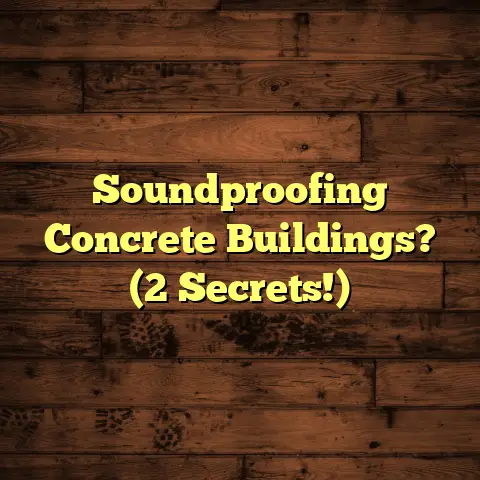Water Resistant Laminate? (5 Lies!)
Have you ever felt the dread of discovering a water spot on your beautiful floor?
I’ve been there, and let me tell you, it’s not a fun experience.
As a flooring contractor with years of experience, I’ve seen firsthand the heartache water damage can cause.
We’re talking about warped planks, swollen edges, and discoloration that can turn your dream floor into a nightmare.
Traditional laminate flooring is often touted for its affordability and aesthetic appeal, but when it comes to water resistance, many homeowners find themselves facing significant issues.
Imagine this: you wake up one morning to find a puddle near your dishwasher.
Panic sets in as you realize the laminate floor in your kitchen is now bubbling up, the edges swollen and discolored.
The once-pristine surface is ruined, and you’re looking at a costly repair or even a full replacement.
This scenario is all too common, especially in areas like kitchens, bathrooms, and basements where moisture is a constant threat.
That’s why I’m here to set the record straight.
Today, we’re diving deep into the world of “water-resistant” laminate and uncovering the truth behind those tempting marketing claims.
Are you ready to separate fact from fiction?
Let’s get started!
Lie #1: “All Laminate is Water Resistant”
Okay, let’s tackle the first big lie: “All laminate is water resistant.”
This is a broad statement that simply isn’t true.
To understand why, we need to differentiate between standard laminate and water-resistant laminate.
Standard laminate flooring is primarily made of a high-density fiberboard (HDF) core, a decorative layer that mimics wood or tile, and a protective wear layer on top.
The HDF core is essentially compressed wood fibers, which are highly susceptible to water damage.
Think of it like a sponge; it soaks up moisture quickly, causing the laminate to swell, warp, and eventually delaminate.
Water-resistant laminate, on the other hand, is designed with enhanced moisture protection in mind.
This often involves a treated HDF core, a tighter locking system to prevent water from seeping between planks, and a water-resistant surface coating.
Some brands even use a waterproof core made of materials like PVC or other composites, but these are often marketed as waterproof, not just water-resistant.
So, what does “water-resistant” really mean?
Well, it’s more about marketing than actual performance.
The term can be quite misleading because it doesn’t specify the level or duration of water exposure the laminate can withstand.
Some products might handle small spills wiped up immediately, while others can tolerate moisture for a longer period before showing signs of damage.
According to the North American Laminate Flooring Association (NALFA), laminate flooring must pass certain tests to be certified, but these tests don’t always reflect real-world conditions like prolonged exposure to standing water.
I’ve seen countless cases where homeowners were lured in by the promise of “water-resistant” laminate, only to find their floors ruined after a minor leak or spill.
Let’s look at a comparative analysis of a few brands to illustrate how consumers can be misled:
| Brand | Claimed Water Resistance | Core Material |
|---|---|---|
| Brand A | Water Resistant | Standard HDF |
| Brand B | Water Resistant | Treated HDF |
| Brand C | Waterproof | PVC Composite |
As you can see, even though Brand A and Brand B both claim water resistance, their core materials differ significantly.
Brand C, on the other hand, uses a waterproof core, making it a more reliable option for areas prone to moisture.
My advice?
Don’t rely solely on marketing terms.
Always check the product specifications, read reviews, and ask your flooring contractor for detailed information about the specific laminate you’re considering.
Lie #2: “Water Resistant Laminate Can Be Submerged”
Moving on to the second lie: “Water resistant laminate can be submerged.”
This is a dangerous misconception that can lead to costly mistakes.
Just because a laminate is labeled as water-resistant doesn’t mean it can withstand standing water or heavy spills without damage.
I’ve seen this play out time and time again.
Imagine a homeowner installing water-resistant laminate in their bathroom, thinking it’s impervious to water.
They neglect to clean up spills promptly, and over time, water seeps into the seams, causing the laminate to swell and buckle.
The result? A ruined floor and a hefty repair bill.
Let me share a real-life example:
I worked on a project where a client installed water-resistant laminate in their basement.
They had a minor flood due to a burst pipe, and the laminate was submerged for several hours before they could address the issue.
Despite being labeled as water-resistant, the laminate planks absorbed water, causing them to warp and separate.
The entire floor had to be replaced.
The science behind laminate materials explains why this happens.
Even with a treated HDF core or a water-resistant surface coating, laminate is still vulnerable to moisture over time.
The edges and seams are particularly susceptible, as water can penetrate these areas and gradually damage the core.
Think of it like this: water-resistant laminate is like a raincoat.
It can protect you from light rain, but it won’t keep you dry in a downpour or if you’re submerged in water.
So, what’s the takeaway here?
Water-resistant laminate is designed to handle small spills and splashes that are cleaned up promptly.
It’s not meant to be a substitute for waterproof flooring in areas with high moisture exposure.
If you’re considering laminate for a bathroom, kitchen, or basement, be realistic about its limitations and take extra precautions to prevent water damage.
This includes promptly cleaning up spills, using rugs and mats in high-traffic areas, and ensuring proper ventilation to reduce moisture buildup.
Lie #3: “All Water Resistant Laminate is the Same”
Now, let’s debunk the third lie: “All water resistant laminate is the same.”
This couldn’t be further from the truth.
The quality and performance of water-resistant laminate products can vary significantly depending on factors like thickness, core material, wear layer, and manufacturing process.
I’ve seen firsthand how these differences can impact the longevity and appearance of a floor.
For example, a thicker laminate plank (e.g., 12mm) typically offers better water resistance and durability than a thinner one (e.g., 8mm).
The thicker core provides more protection against moisture penetration and is less likely to warp or swell.
The core material also plays a crucial role.
As we discussed earlier, a treated HDF core offers better water resistance than a standard HDF core.
Some brands even use specialized cores with enhanced moisture protection, such as those infused with water-repellent agents.
The wear layer, which is the top protective layer of the laminate, also affects its water resistance.
A thicker, more durable wear layer can better protect the core from moisture and prevent scratches and stains.
Price is another factor to consider, but it’s not always an indicator of quality.
I’ve seen expensive laminates with poor water resistance and budget-friendly options that perform surprisingly well.
It really boils down to understanding the product specifications and reading reviews from other homeowners.
To enrich our discussion, I spoke with a flooring specialist, Sarah Miller, who has been in the industry for over 15 years.
She emphasized the importance of researching different brands and products before making a decision.
“Don’t just go for the cheapest option,” she advised.
“Look at the core material, wear layer, and warranty.
A little extra investment upfront can save you a lot of headaches down the road.”
So, how do you choose the right water-resistant laminate?
Start by considering the specific needs of your space.
If you’re installing laminate in a bathroom or kitchen, opt for a thicker plank with a treated HDF core and a durable wear layer.
Read reviews from other homeowners and ask your flooring contractor for recommendations.
Don’t be afraid to ask questions about the product’s water resistance and warranty.
Lie #4: “Water Resistant Laminate Requires No Special Care”
Let’s move on to the fourth lie: “Water resistant laminate requires no special care.”
This is a common misconception that can lead to neglect and ultimately, floor damage.
While water-resistant laminate is designed to withstand moisture better than standard laminate, it’s not completely maintenance-free.
Regular cleaning and proper care are essential to ensure its longevity and performance.
I’ve seen countless cases where homeowners assumed their water-resistant laminate was invincible and neglected to clean up spills promptly.
Over time, this neglect led to water damage, staining, and even mold growth.
So, what are the necessary maintenance practices for water-resistant laminate?
First and foremost, clean up spills immediately.
Don’t let water sit on the surface for extended periods, as it can seep into the seams and damage the core.
Use a damp cloth or mop to clean the floor regularly.
Avoid using excessive water, as this can also lead to moisture damage.
Use a pH-neutral cleaner specifically designed for laminate floors.
Avoid using harsh chemicals, abrasive cleaners, or steam mops, as these can damage the wear layer and reduce the laminate’s water resistance.
Place rugs and mats in high-traffic areas, such as entryways and kitchens, to protect the floor from scratches, dirt, and spills.
Ensure proper ventilation in bathrooms and kitchens to reduce moisture buildup.
Now, let’s talk about warranty claims.
Most laminate flooring manufacturers offer warranties that cover defects in materials and workmanship.
However, these warranties typically exclude damage caused by improper maintenance, neglect, or abuse.
If you fail to follow the recommended cleaning and maintenance practices, you could void your warranty and be stuck paying for repairs out of pocket.
My advice?
Read the manufacturer’s instructions carefully and follow the recommended cleaning and maintenance practices.
Keep records of your cleaning and maintenance efforts, as this can be helpful if you need to file a warranty claim.
By taking proper care of your water-resistant laminate, you can extend its lifespan and keep it looking beautiful for years to come.
Lie #5: “Water Resistant Laminate is Indestructible”
Finally, let’s tackle the fifth and final lie: “Water resistant laminate is indestructible.”
This is perhaps the most dangerous misconception of all.
While water-resistant laminate is designed to withstand moisture and wear and tear, it’s not impervious to damage.
It can still be scratched, dented, and damaged by heavy foot traffic, sharp objects, and improper care.
I’ve seen countless cases where homeowners assumed their water-resistant laminate was invincible and treated it carelessly, only to find it damaged and worn out in a short period of time.
So, what are the limitations of water-resistant laminate in terms of durability?
First, it’s important to understand that the wear layer, which is the top protective layer of the laminate, is not scratch-proof.
It can still be scratched by sharp objects, such as furniture legs, pet claws, and high heels.
Heavy foot traffic can also wear down the wear layer over time, making the laminate more susceptible to scratches and stains.
Dents are another common issue with laminate flooring.
Dropping heavy objects, such as pots and pans, can dent the surface of the laminate, especially if it’s installed over an uneven subfloor.
Water-resistant laminate is also susceptible to fading from prolonged exposure to sunlight.
The UV rays can cause the colors in the decorative layer to fade over time, especially in areas near windows.
To give you a personal touch, I want to share a testimonial from a homeowner named Sarah who experienced issues with her water-resistant laminate flooring.
“I installed water-resistant laminate in my kitchen thinking it would be worry-free,” she said.
“But after a few months, I noticed scratches and dents in high-traffic areas.
I also spilled some red wine, and even though I cleaned it up right away, it left a stain.”
Sarah’s experience highlights the importance of understanding the limitations of water-resistant laminate and taking proper care to protect it from damage.
So, how do you protect your water-resistant laminate from damage?
Use furniture pads under the legs of chairs and tables to prevent scratches.
Trim your pet’s nails regularly to minimize scratches.
Avoid wearing high heels on the laminate floor.
Place rugs and mats in high-traffic areas to protect the wear layer.
Clean up spills immediately to prevent staining.
Use window coverings to reduce sunlight exposure.
By taking these precautions, you can extend the lifespan of your water-resistant laminate and keep it looking beautiful for years to come.
Conclusion
Alright, we’ve reached the end of our myth-busting journey through the world of water-resistant laminate flooring.
Let’s recap the key points we’ve covered:
-
Not all laminate is water resistant.
-
Water-resistant laminate cannot be submerged.
-
All water-resistant laminate is not the same.
-
Water-resistant laminate requires special care.
-
Water-resistant laminate is not indestructible.
I hope this article has shed some light on the truths behind water-resistant laminate flooring and helped you make informed decisions about your flooring needs.
Remember, while water-resistant laminate can be a suitable choice for certain environments, it’s essential to be realistic about its limitations and care requirements.
Do your research, read reviews, and consult with professionals before making any flooring decisions.
Don’t fall for the marketing hype and empty promises.
By being well-informed and proactive, you can avoid potential pitfalls and regrets and create a beautiful, long-lasting floor that you’ll love for years to come.
Thanks for joining me on this journey!
If you have any questions or comments, feel free to leave them below.
And remember, happy flooring!





